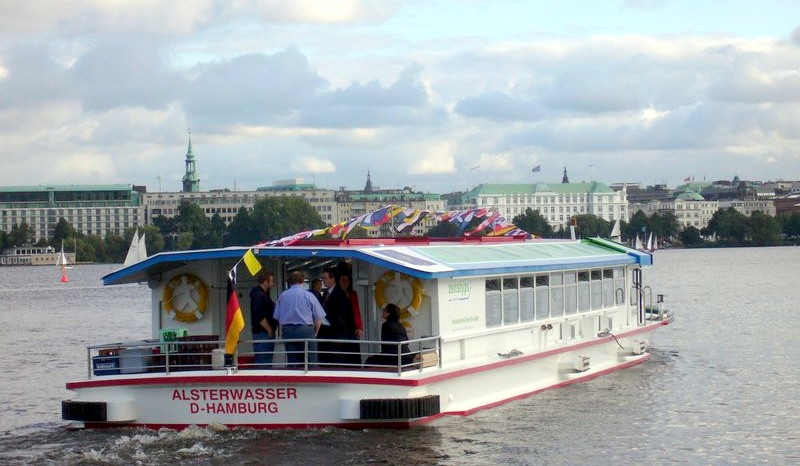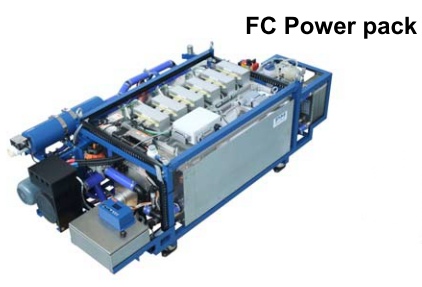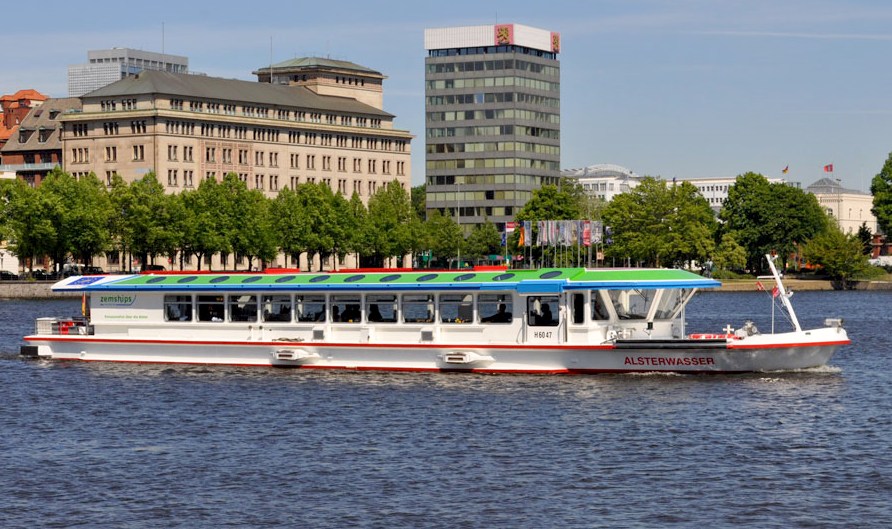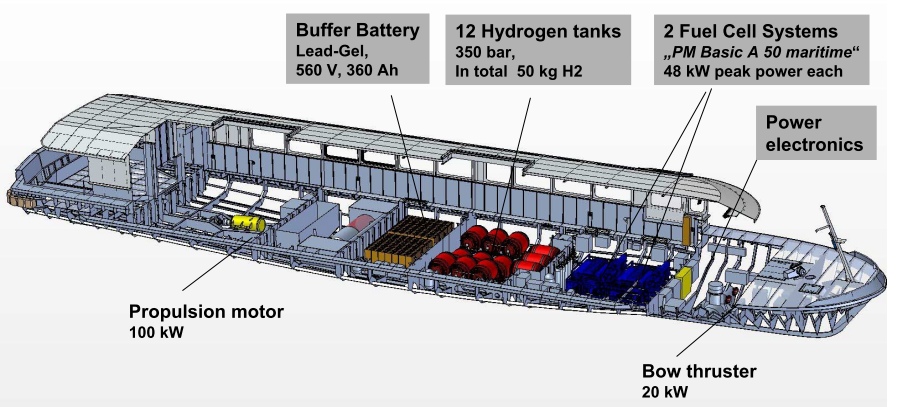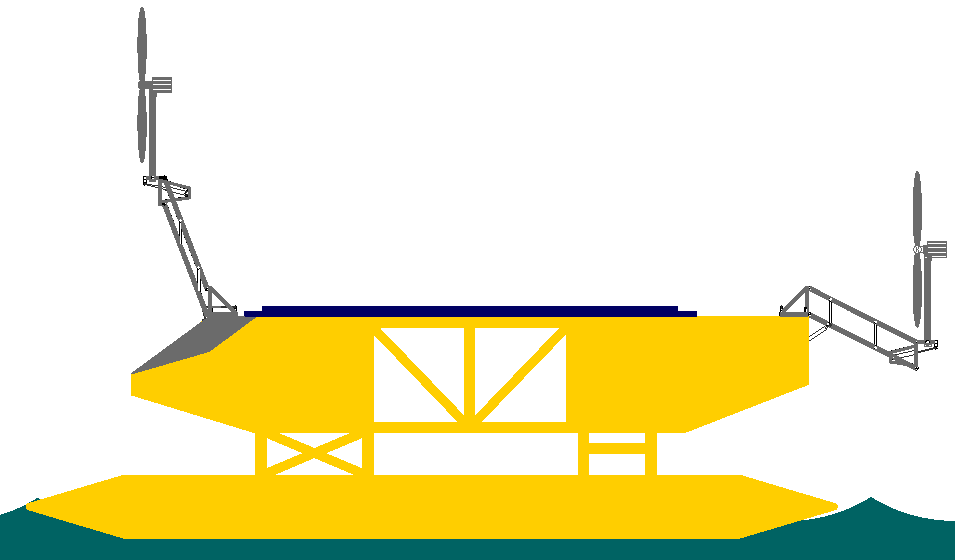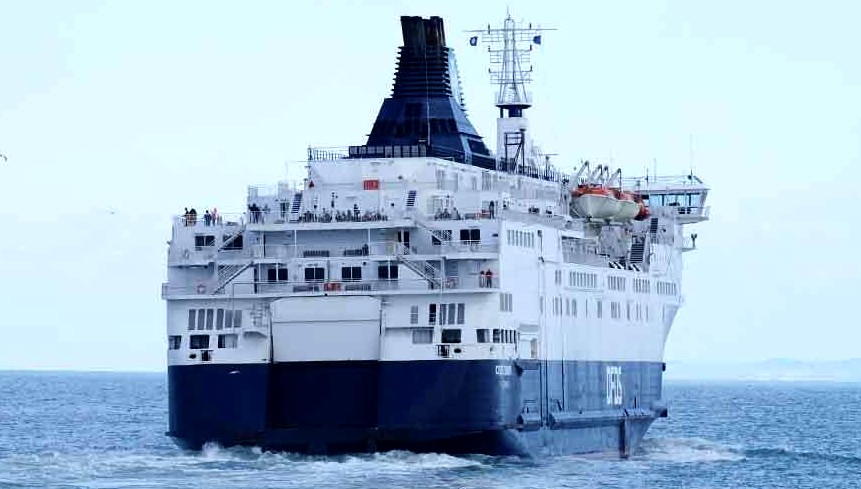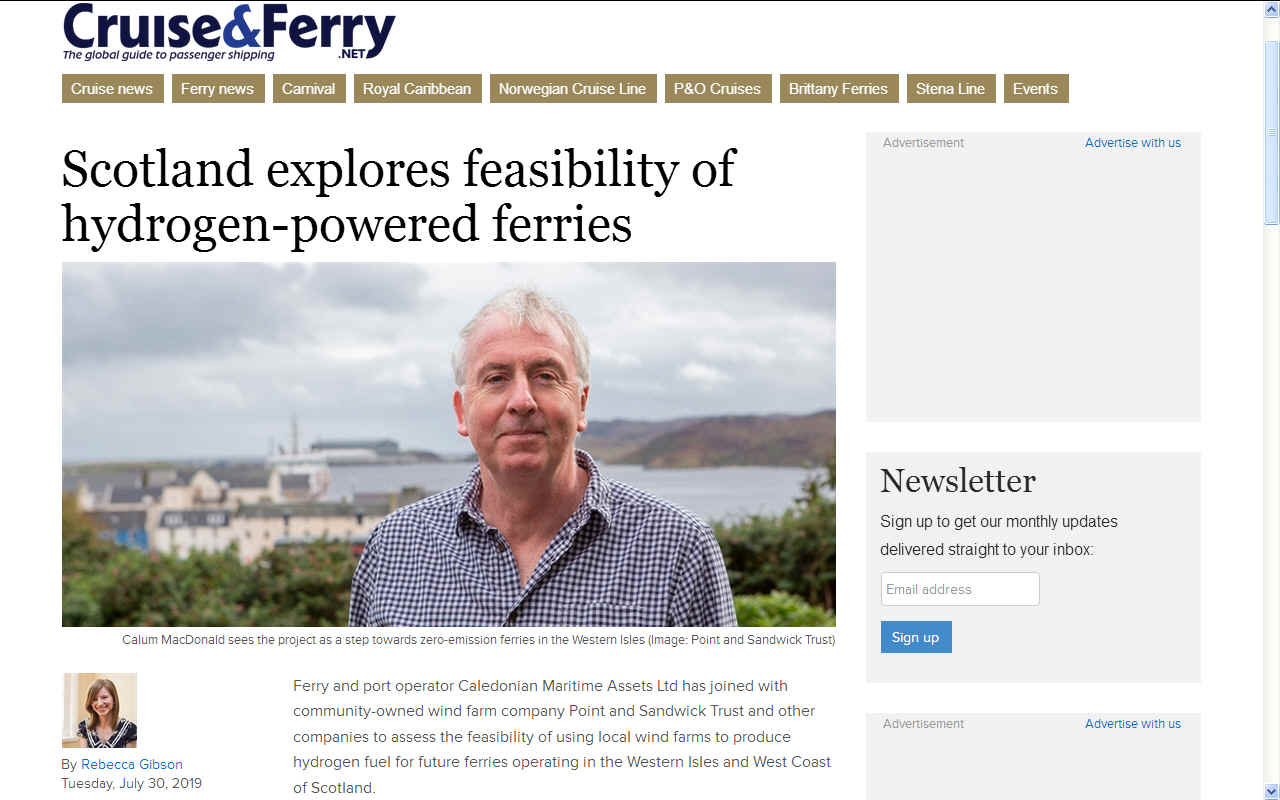|
FCS ALTSERWASSER - RIVERBOAT, HAMBURG
ABOUT - CLIMATE CHANGE - CONTACTS - FERRY OPERATORS - HOME - OCEAN PLASTIC PLEASE USE OUR A-Z INDEX TO NAVIGATE THIS SITE
HZWEI 30 SEPTEMBER 2014
- Während sich Hamburg mitunter gerne als Wasserstoff-Hochburg feiert, gibt es auch hier ebenso wie anderswo Probleme mit der H2-Infrastruktur: Wie im Umfeld der H2Expo bekannt wurde, liegt das brennstoffzellenbetriebene Fahrgastschiff FCS Alsterwasser seit geraumer Zeit still, weil keine Betankungsmöglichkeit mehr besteht. Heinrich Klingenberg von hySolutions bestätigte gegenüber HZwei, dass das Schiff bereits seit Herbst 2013 nicht mehr betriebsbereit ist; es sei jedoch technisch in Schuss. Der Betreiber, die ATG Alster-Touristik GmbH, ist zwar durchaus noch an einem weiteren Betrieb interessiert, nicht jedoch das Gaseunternehmen Linde an einem weiteren Betrieb seiner Tankstelle am Anleger Hellbrookstraße im Barmbeker Stichkanal. Wie ein Unternehmenssprecher HZwei erklärte, wurde die an der Außenalster gelegene Betankungsstation, die im Rahmen eines europäischen Fördervorhabens (s. HZwei-Heft Okt. 2008) für die Erprobung technischer Komponenten errichtet worden war, im Frühjahr 2014 abgebaut. Als Grund dafür nannte er, dass der Betrieb nicht wirtschaftlich sein kann, wenn das Schiff zum Teil mit dem Strom aus den an Bord befindlichen Batterien fährt und nur alle drei Tage zum Tanken vorbeikommt. Weiter hieß es von Linde: Wir sehen mehr Potential auf der Straße als auf dem Wasser.
HZWEI SEPTEMBER 30 2014 - The fuel cell ship Alsterwasser is still
Although the operator, ATG Alster-Touristik GmbH, is still interested in another operation, it is not the gas company Linde that is involved in another operation of its filling station at the Hellbrookstraße in the Barmbeker Stichkanal. As a company spokesman HZwei explained, the refueling station at the Außenalster, which was built as part of a European funding project (see HZwei-Brosch, Oct. 2008) for the testing of technical components, was dismantled in the spring of 2014. The reason for this he said, "that the operation can not be economical", when the ship runs partly with the power from the on-board batteries and "only comes by every three days for refueling". It was also said by Linde: "We see more potential on the road than on the water."
Whether there will be a new fueling option for the Alsterwasser, whether from another provider or elsewhere, is currently still open. A possible alternative could be a conversion of the H2 filling station in HafenCity, reported Klingenberg. Talks are in progress in this regard, however, the ship then would have to go to the refueling of the Alster through the town hall lock in the Elbe and thereby to the Tide judge. In addition, because of the tidal differences flexible connections and for the
traffic ability of the waterway regular excavation work would be necessary. This year will probably be nothing more. However, Klingenberg was confident about finding a solution for the next season.
Why was the hydrogen filling station equipped with a 17qm (17,000 l) storage tank for liquid hydrogen (-253 ° C)?
Because only liquid hydrogen without pipe system can be transported reasonably profitable. It is still as light as Styropur but has at least a higher volume density than even today's 700bar pressure tanks!
Dumb only that the liquid hydrogen volatilizes in case of missing (continuous) decrease despite isolation (blow out) - or energy-intensive constantly must be cooled. That costs (permanently) money, but is not liked by the advocates of the H2 technology like some other facts.
This is known since 2003 at the latest ("Hydrogen does not solve energy problems"). But the public accounts of hydrogen like to ignore also comprehensible, founded by general laws of nature facts. Hydrogen is simply not an energy source, only an energy source that always has to be produced with great effort!
MARITIME PROPULSION OCTOBER 17 2012
Company Proton Motor Fuel Cell GmbH, Puchheim, Germany, developed the 48-kW PM Basic A 50 maritime fuel cell system for the zero-emission drive and integrated two such systems, along with a lead gel battery, into the ship as a hybrid system. The systems were certified for maritime operations by Germanischer Lloyd. An intelligent energy management system coordinates the division of work between fuel cells and battery. Up to 50 kg of gaseous hydrogen is stored onboard in 350-bar pressurized tanks in order to provide sufficient fuel for around three days of use. This hybrid-combination ensures highest functionality and durability. Hydrogen and oxygen conjoins inside the fuel-cell to water. At this process, which is also called cold combustion, power is generated.
OCTOBER 24 2012
- FCS Alsterwasser: The First Ship Powered by Hydrogen Fuel Cells
FUEL CELL TODAY 01 SEPTEMBER 2008
- Naming of the Fuel Cell FCS Alsterwasser ZemShip
This
makes the ZemShip the worlds first project resulting in a fuel cell-driven passenger ship. Proton Motor developed the 48-kW PM Basic A 50 maritime fuel cell system for the zero-emission drive and integrated two such systems, along with a lead gel battery, into the ship as a hybrid system. The systems were certified for maritime operations by Germanischer Lloyd. An intelligent energy management system coordinates the division of work between fuel cells and battery. Up to 50 kg of gaseous hydrogen is stored onboard in 350-bar pressurised tanks in order to provide sufficient fuel for around three days of use.
- SOLAR & WIND POWERED FERRY - The Cross Channel Challenger (CCC) was a project on the drawing board in 2019 looking for backing to develop a coastal cruiser that is zero carbon just like the hydrogen projects, but where the vessel converts energy from nature onboard for propulsion without risk of hydrogen leaks or fires.
This is a toe-in-the-water project using budget off the shelf equipment to keep the costs down. Hence, the theoretical performance is lower than might be achieved but higher than the current benchmark. It is a useful stepping stone to medium range ferries and eventually bigger ships with longer ranges. Solar combined with wind power could be the winning combination. Comparing the two technologies will be interesting. For sure, the solar powered ferries will be safer and cheaper.
Solar and wind powered vessels do not need big hydrogen tanks next to docks for ships to fill up from. They do not need trucks to deliver the hydrogen from the conversion plants and last but not least, hydrogen is potentially dangerous, as the Zeppelin 'Hindenburg' demonstrated in 1937 when a spark ignited the fated airship, destroying it in minutes.
Since 2019, a study in July 2021 has shown that the hull design in basic, could be adapted to cross the Atlantic on hydrogen power alone, with solar assistance, as a top up power source. Food for thought for Waterborne and Zero Emission Waterborne Transport (ZEWT) advocates in Europe. The aim would be to adapt the concept to practical ZESTA ferries, especially for island nations who depend on shipping for their economies. The proposed design is also safer, leak wise.
CONVERSION, CONVERSION, CONVERSION - It is the number of additional stages of splitting water using electricity, storing as a gas and then recombining it to extract the electricity that was put in at the beginning at a huge net energy loss. Elon Musk has a point don't you think?
Hydrogen is recognised as a fuel with the potential to deliver 100% zero-carbon operation in marine transport, but the systems proposed so far are expensive and complicated, where the first rule of engineering is to Keep It Simple Stupid: KISS.
The allure of the hydrogen economy is plain, splitting ordinary water using electrolysis to obtain oxygen and hydrogen gas is like a schoolboy chemist dream come true, especially if we can generate what appears to be free electricity using solar cells and wind turbines to split the water. Then the hydrogen is free right?
No, not really.
There is a cost, including the cost of manufacturing the solar panels or wind turbines and the transmission line installation and maintenance. The inefficiencies in the conversion and handling chain make hydrogen expensive to produce and so potentially un-competitive - as compared to using the electricity needed to convert water, directly.
In addition, hydrogen is dangerous unless stored very carefully. Space rockets powered by hydrogen and oxygen sometimes explode, with the Hindenburg zeppelin explosion being signs of things to come in a world fraught with human error. We'd be courting disaster. If something can happen, it will happen. Passengers would be traveling in potential time bombs.
CONTACTS
....
A-Z
INDEX OF H2 POWERED FUEL CELL SHIPS
FERRY OPERATORS & ISLAND SERVICES
DFDS -
LINKS & REFERENCE
https://www.hzwei.info/blog/2014/09/30/das-brennstoffzellen-schiff-alsterwasser-liegt-still/ https://maritime-executive.com/article/hydrogen-fuel-cell-vessels-destined-for-france-and-norway https://grist.org/article/a-ferry-that-runs-on-hydrogen-fuel-cells-is-coming-to-san-francisco/
ADRIATIC SEA - ARCTIC OCEAN - ATLANTIC OCEAN - BALTIC SEA - BAY OF BENGAL - BERING SEA - CARIBBEAN SEA CORAL SEA - EAST CHINA SEA - ENGLISH CHANNEL - GULF OF GUINEA - GULF OF MEXICO - INDIAN OCEAN - IRISH SEA MEDITERRANEAN SEA - NORTH SEA - PACIFIC OCEAN - PERSIAN GULF - SEA OF JAPAN - SOUTH CHINA SEA - SOUTHERN OCEAN
STUDY
PUBLISHED - Point and Sandwick Trust, in collaboration with a number of industry partners (Wood, Siemens-Gamesa, Engie, ITM, CMAL, Johnston Carmichael and Ferguson Marine), have published a feasibility study to assess the suitability of using hydrogen produced from local wind farms to power future ferry services operating in the Western Isles and West Coast of Scotland.
This website is provided on a free basis as a public information service. Copyright © Cleaner Oceans Foundation Ltd (COFL) (Company No: 4674774) 2019. Solar Studios, BN271RF, United Kingdom. COFL is a charity without share capital.
|

